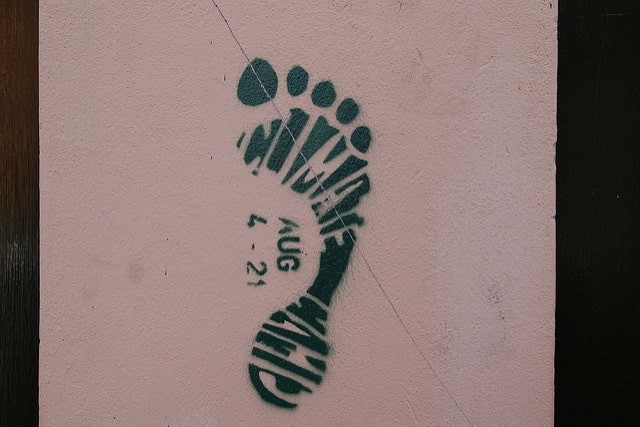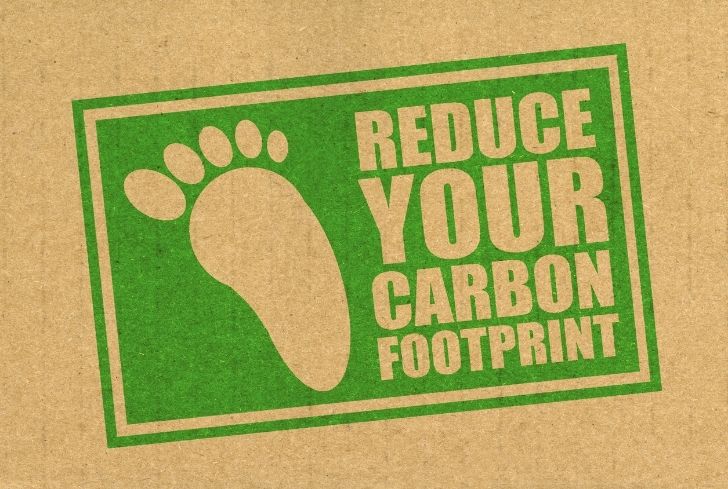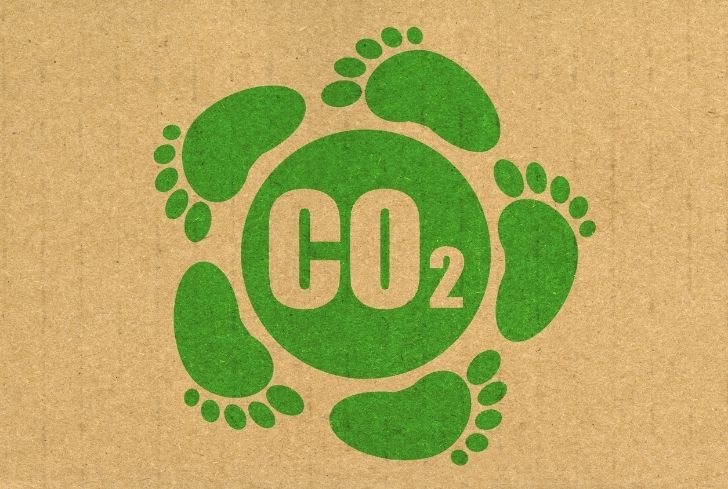The amount of carbon dioxide we produce has become a big environmental issue. While the problem may seem too large to handle, it starts with each individual person’s carbon footprint and what they can do to lessen the impact they have on the environment. A carbon footprint is an amount of carbon dioxide a specific person, or place releases into the atmosphere.
According to TakePart,
“A carbon footprint is the amount of greenhouse gases—primarily carbon dioxide—released into the atmosphere by a particular human activity. A carbon footprint can be a broad meaasure or be applied to the actions of an individual, a family, an event, an organization, or even an entire nation. It is usually measured as tons of CO2 emitted per year, a number that can be supplemented by tons of CO2-equivalent gases, including methane, nitrous oxide, and other greenhouse gases. “
40 Remarkable Ways To Reduce Your Carbon Footprint and Help the Environment
There are many ways to reduce your carbon footprint, such as the following.
1. Don’t drive. There are many different ways to get around, aside from driving. You could walk or ride a bike in order to completely eliminate the amount of carbon emissions you create getting around besides keeping you fit. For longer distances, carpooling and public transportation produce much less carbon emissions than if everyone were to drive their own car.
2. Avoid aggressive driving. If you have to drive, avoid unnecessary braking and acceleration. Some studies found that aggressive driving can result in 40% more fuel consumption than consistent, calm driving.
3. Buy an electric car. Electric cars produce no carbon emissions and can easily be charged at your home. They are becoming increasingly popular, and it is expected a shift from fuel-powered cars to electric cars will happen gradually.
4. Do not buy a fuel-heavy car. If you rarely use the extra space provided by a minivan or an SUV, consider buying a hitch-mounted cargo rack instead.
5. Make sure your tires are properly inflated. It is estimated that your gas mileage could improve by 3% if your tires are properly inflated.
6. Give your car regular maintenance. If your car is faulty, it could negatively impact your fuel efficiency by up to 40%. In comparison, ensuring that car is properly maintained can increase efficiency by four percent.
7. Use your car efficiently. Remove any extra weight from the car. On longer trips, turn on the cruise control, which can save gas. Use less air conditioning while you drive, even when the weather is hot. Use traffic apps to avoid getting stuck in traffic jams.
8. Avoid busy roads. Getting stuck in a traffic jam is a fast way to waste your gas and create unnecessary carbon emissions.
9. Plan your outings. If you have errands to run, plan the outing in a way that requires you to drive the least amount of time. Try not to drive in circles, but instead stop along the way.
10. Buy locally grown goods and products. You should buy locally-grown goods and products because they don’t rack up the largest carbon footprints getting to the market.
11. Buy products with less packaging. When you go shopping, try to buy things with less packaging like loose carrots rather than plastic-wrapped or boxed carrots.
12. Don’t buy trendy items. Trendy, cheap items that go out of style quickly get dumped in landfills where they produce methane as they decompose. Average American discards about 80 pounds of clothing each year, 85 percent of which ends up in landfills. As most fast fashion comes from China and Bangladesh, so shipping it to the U.S. requires the use of fossil fuels. Buy quality clothing that will last.
13. Avoid flying. The fuel used for airplanes is petroleum-based, making it extremely detrimental to the environment. Until there is a less polluting fuel substitute implemented for aviation, it would be best to avoid flying altogether.
14. Avoid using heating. Invest in making sure your home is properly insulated. This will help prevent coldness. Try your best to avoid adjusting your thermostat too much.
15. Go economy class. If you can’t avoid flying, go for economy class. Business-class is responsible for almost three times as many emissions as the economy because, in the economy, the flight’s carbon emissions are shared among more passengers; first-class can result in nine times more carbon emissions than the economy. Also, offset the carbon emissions of your travel.
16. Go for Carbon Offsets. A carbon offset is an amount of money you can pay for a project that reduces greenhouse gases somewhere else. If you offset one ton of carbon, the offset will help capture or destroy one ton of greenhouse gases that would otherwise have been released into the atmosphere. Offsets also promote sustainable development and increase the use of renewable energy.
17. Buy energy-efficient products. Appliances around the house use a lot of electricity, which in turn causes your carbon footprint to grow. Buying appliances that help to minimize energy consumption will save you a lot of money in the long run. If shopping for appliances, lighting, office equipment or electronics, look for Energy Star products that are certified to be more energy efficient.
18. Turn off your lights. Never leave a light burning when you are not in the room. It would also be a good idea to use energy-saving light bulbs.
19. Use LED. Change incandescent light bulbs to light-emitting diodes (LEDs) as the former waste 90% of their energy as heat. Though LEDs cost more, they use a quarter of the energy and last up to 25 times longer. They are also preferable to compact fluorescent lamp (CFL) bulbs, which emit 80% of their energy as heat and contain mercury.
20. Use Sun’s energy. If you can afford it, install solar panels on the roof of your house. This is a sustainable source of energy that you can use that will not cause any carbon emissions. It will also eliminate your electricity bill.
21. Support local businesses. Transportation of products leads to carbon emissions. Buying products that did not need to be transported will improve your local economy and reduce carbon emissions.
22. Go vegan. Cows produce large amounts of methane gas, and raising them depletes many resources. Deforestation can occur in order to make room for cow farms, which reduces the number of trees available to combat carbon emissions.
23. Monitor your water usage. Buy water-efficient appliances such as dishwashers and washing machines. You can also install drip irrigation in your garden to prevent overwatering your plants.
24. Reuse products. Containers and other similar items can be used in a variety of different ways. For example, reusing gift bags, you receive on special days could reduce your carbon footprint.
25. Recycle. If you truly do not have a way to use something anymore, dispose of it through recycling. This will lessen the need for new resources to be created, which will lead to less carbon emissions. For example, recycling paper leads to fewer trees being cut down.
26. Advocate for renewable energy sources. Try to convince your local government, or even just your own circle of friends, to start using solar or other clean energy sources instead of fossil fuels that cause carbon emissions.
27. Don’t bathe. Showering uses nearly five times less energy than taking a bath. You can also install a low-flow showerhead that reduces the amount of water that is used.
28. Unplug devices. If you aren’t using a device, turn it off at the socket or unplug it. Phone chargers are often left permanently and not just when a phone is being charged. It uses the same amount of energy even when a phone isn’t plugged in, and that is energy wasted.
Never forget to pull out appliances’ plugs, because they use small electricity amount even they are off. Get your home properly insulated and utilize thermostat. In this way, your heater and air condition will use less amount of energy.
29. Wash your clothes with cold water. You try to use cold water while washing things that do not need to be washed in hot water. A large amount of carbon emissions is produced because water needs to be heated. It takes more energy and increases loads, which is a big footprint. Using cold water would have the same result with fewer carbon emissions.
30. Use a laptop. Desktop computers use 80% more battery than a laptop and perform nearly similar functions. Unless you absolutely need an extremely fast processor, it would be the smart choice to buy a laptop instead of a desktop computer. Laptops are also easier to transport.
31. Use recyclable trash bags. Black trash bags are notorious because the black pigmentation cannot be recycled, making them a huge strain on our resources. The best way to prevent trash bags from polluting our environment is to switch to white or recyclable trash bags. There are also people who use almost no trash bags and instead have compost heaps and their own recycling initiative. While this might not be practical for everyone, it is something to consider.
32. Do not buy bottled water. If you live in a western country, the chances are that your tap water is completely safe to drink. Not only does bottled water produces plastic pollution, but it is also very expensive. If you are still scared of drinking tap water, consider installing a filter into your tap itself. This will only be a once-off cost and will not be as hazardous as plastic water bottles. Bottled water has had large carbon footprints. Try to use canteen or re-useable water bottles.
33. Start your own garden. If you start growing your own food, you will save money and help the environment. Be sure not to overwater your plants and try not to plant anything that is not suited to the climate that you live in.
34. Switch to rechargeable batteries. This goes without saying, but reusing batteries will help the environment a lot since it produces less wait. Rechargeable batteries are readily available and affordable, there’s really no reason not to use them.
35. Avoid the stove.If you need to heat up your food, opt for the microwave instead. It uses much less energy than a stove and usually much faster as well. It would be best to completely limit the use of both of these devices when you can.
36. Read magazines and newspapers online. Almost all popular magazines and newspapers have online subscriptions available. This will cut down on paper consumption, and you won’t have to drive to a store to buy the product, causing fuel emissions.
37. Get an e-reader. This will cut down on the amount of paper used to produce books. It is also more convenient since you will have a large selection of books on a single device. It is important to only plug in the e-reader’s charger when you are charging it in order to save energy. If you prefer real books, consider joining a library instead of buying your own.
38. Set your water heater to vacation mode.Set your water heater to vacation mode when you are out for a long period. Vacation mode is a water heater setting that enables water heater users to reduce a water heater’s energy consumption while powering it with just enough energy to prevent frozen pipes.
39. Try more holistic remedies. Instead of taking prescription medications and antibiotics, try more holistic remedies. Try natural products as much as possible. Too many antibiotics wipe out the good bacteria in your body, making you more susceptible to illness. Healthcare, including pharmaceutical production, in the U.S., makes up 8% of the nation’s carbon emissions. Stay healthy but cut your footprint where possible.
40. Plant a tree. This will cancel out some of the carbon emissions you create. Trees produce oxygen from these carbon emissions, and with the looming threat of deforestation, planting a tree would be a good idea.








